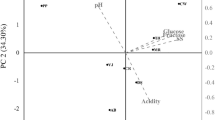Abstract
Major sugar and carboxylic acid components in apricot flesh fruits were detected and quantified. Fifty-one genotypes including clones growing in France, Spain, Italy, Greece and USA, belonging to the INRA germ plasm collection has been evaluated. Principal component analysis (PCA) has been performed to study correlation among fruit quality measurements and to interpret relationships between genotypes as a tool for germ plasm characterization. A marked variation in malic and citric acid content has been observed and PCA revealed clusters of apricot genotypes for the malic/citric ratio content. A good correlation between sugar component and refractometer index (r = 0.83) has been detected. The wide range of diversity in malic and citric acid content in apricot germ plasm makes it possible to breed and select genotypes with improved flavour on the basis of superior phenotypes.
Similar content being viewed by others
References
Agarval, J.D. & W.B. Date, 1966. Organic acids in fresh and canned apricots. J Food Sci Technol 3(2): 70.
Anet, E.F.L.J. & T.M. Reynolds, 1955. Water soluble constituents of fruits. II. — The separation of acids on anion exchange resins: the isolation of 1–quinic acid from apricots. Aust J Chem 8: 267–275.
Alvisi, F., 1997. Situazione e prospettive della produzione e commercializzazione delle albicocche nel mediterraneo. In: Atti del Convegno Nazionale S.O.I. ‘La coltura dell'albicocco, una realtà mediterranea', Imola (Italy). Italus Hortus 2: 7–11.
Audergon, J.M., M. Souty & L. Breuils, 1990. Amélioration génétique pour l'obtention d'abricots de qualité In: 9o Colloque sur les recherches fruitières: 217–228, 4–5–6 Décember, Avignon (France).
Audergon, J.M., M. Reich & M. Souty, 1991. Abricot: variations des critères de qualité. Arboriculture fruitière 436: 35–45.
Audergon, J.M. & M. Souty, 1994. Influence des facteurs génétiques et des conditions environnementales sur la qualité des fruits à la récolte: 101–124. In: Post Harvest Quality and Derived Products in Stone-Fruits, October 17–18, Lleida (Spain).
Badenes, M.L., J. Martinez-Calvo & G. Llácer, 1998. Analysis of apricot germplasm from the European Eco-geographical group. Euphytica 102: 93–99.
Bailey, C.H. & L.F. Hough, 1975. Apricots. In: J. Janick & J.N. Moore (Eds.), Advances in Fruit Breeding, pp. 367–383. Ind. Purdue Univ. Press, West Lafayette.
Bassi, D. & R. Selli, 1990. Evaluation of fruit quality in peach and apricot. Adv Hort Sci 4: 107–112.
Bassi, D. & F. Bartolozzi, 1991. Quality fruit traits in apricot (Prunus armeniaca L.) progenies. In: Deuxièmes rencontres sur l'abricotier: 77–87, 27–31 May, Avignon (France).
Bassi, D. & F. Bartolozzi, 1993. Il miglioramento genetico dell'albicocco: obiettivi e strategie. Rivista di Frutticoltura 5: 41–50.
Bassi, D., F. Bartolozzi & E. Muzzi, 1996. Patterns and heritability of carboxylic acids and soluble sugars in fruits of apricot (Prunus armeniaca L.). Plant Breeding 115: 67–70.
Battistini, S. & S. Sansavini, 1989. Il polimorfismo isoenzimatico nelle cultivar di albicocco: 291–300. Atti del IX Convegno Internazionale dell'albicocco, 9–15 Luglio, Caserta (Italy).
Boheringher Mannheim, 1993. Méthodes Enzymatiques pour l'Analyse Agro Alimentaire, (France).
CEMAGREF, 1988. La qualité gustative des fruits. Bases physiologiques et méthodes pratiques d'analyse. Ministère de l'Agriculture, France.
Crossa-Raynaud P.H. & J.M. Audergon, 1991. Some reflection on apricot selection. IX International Symp. on Apricot Culture, Caserta (Italy), 1989, Acta Hort 293(1): 73–85.
Faust, M., D. Surányi & F. Nyuitó, 1996. Origin and Dissemination of Apricot. Horticultural Reviews 22: 225–266.
Guichard, E. & M. Souty, 1988. Comparison of the relative quantities of aroma compounds found in fresh apricot (Prunus armeniaca) from six different varieties. Z Lebensem Unters Forsch 186: 301–307.
Iezzoni, A.F. & M.P. Pritts, 1991. Applications of principal component analysis to Horticultural research. HortScience 26(4): 334–358.
Mehlenbacher, S.A. V. Cociu & L.F. Hough, 1990. Apricots (Prunus). In: J.N. Moore & J.R. Ballington Jr. (Eds.), Genetic Resources of Temperate Fruit and Nut Crops 1: 65–107. Published by the International Society for Horticultural Science, Wageningen, the Netherlands.
Moreau-Rio, M.A. & C. Roty, 1998. L'abricot. Perceptions et attentes des consommateurs francais. Infos-Ctifl 141: 16–21.
Preda, S. & S. Tondini, 1997. Produzione e scambi mondiali delle albicocche fresche e trasformate. Rivista di Frutticoltura 7/8: 59–63.
Souty, M., L. Breuils, M. Reich & A. Poggi, 1976. L'acidité des abricots. Fruits 31(12): 775–779.
Souty, M., J.M. Audergon & Y. Chambroy, 1990. Abricot, Les critères de qualité. Arboriculture fruitière 430: 18–24.
Author information
Authors and Affiliations
Rights and permissions
About this article
Cite this article
Gurrieri, F., Audergon, JM., Albagnac, G. et al. Soluble sugars and carboxylic acids in ripe apricot fruit as parameters for distinguishing different cultivars. Euphytica 117, 183–189 (2001). https://doi.org/10.1023/A:1026595528044
Issue Date:
DOI: https://doi.org/10.1023/A:1026595528044




